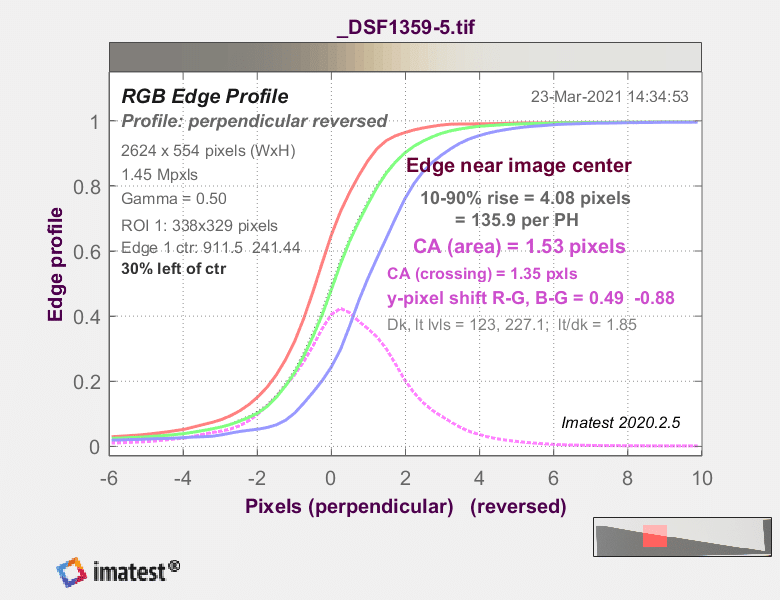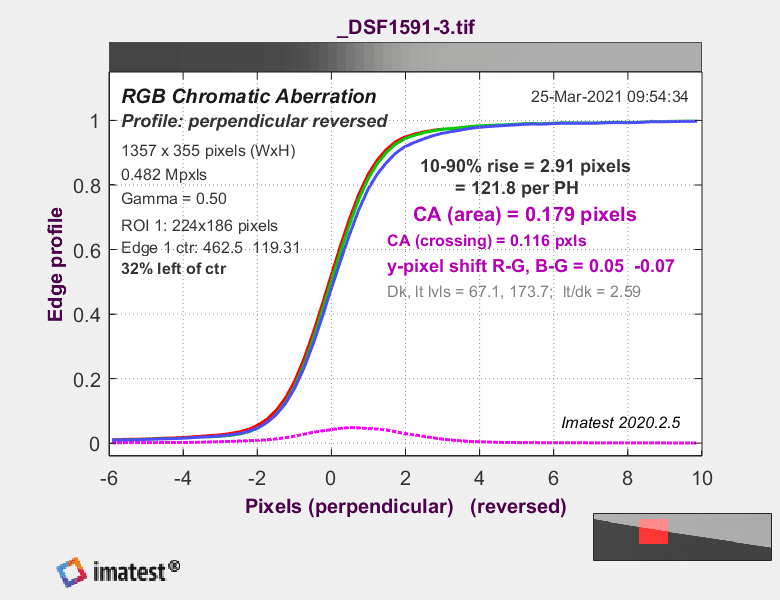This is one in a series of posts on the Fujifilm GFX 100S. You should be able to find all the posts about that camera in the Category List on the right sidebar, below the Articles widget. There’s a drop-down menu there that you can use to get to all the posts in this series; just look for “GFX 100S”.
I have a long and tedious test I use to check for longitudinal chromatic aberration (LoCA). The test involves a backlit razor blade, a computerized, motorized focusing rail, and a lot of messing around. It also has the disadvantage that is needs to be performed at short focusing distances, which may not be representative of the most common use cases. When I performed that test on the Fuji 110 mm f/2, it did great.
Imatest has a chromatic aberration test that, while incapable at distinguishing between LoCA and lateral chromatic Aberration (LaCA), can be performed at longer distances — I used about 14 meters for this test for the 110 and 8 meters for the 80 — and is much faster to run.
The protocol for the test:
- f/4
- C1 head
- RRS legs
- Sinusoidal Siemens star for focusing.
- Slanted edge above it
- Electronic shutter
The new result, developed in Lightroom 10.2 with sharpening turned off, and white balance to the gray of the slanted edge.
Here’s what the Imatest results were for the 80 mm f/1.7 lens used with 16-bit pixel shift on the GFX 100S.
And here’s what it looks like for the 110/2:


Alan says
Do you think the 80/1.7 will be much better at f/2 or f/2.8?
JimK says
The test was performed at f/4.
Dimy says
I would be more interested in LoCa wide open and in normal camera conditions without pixel shift. That is what this lens is made for and why people are paying and carrying the weight.
JimK says
Pixel shift allows a good look at the LoCA, without the confounding effects of Bayer demosaicing.
Dimy says
I can also reassure you that you will never see any demosaicing algorithm effects relevant to your lens :
1. It’s software inside the camera disjunct from hardware differences!
2. The lenses will ALWAYS have a resolution much worse by a factor over 4 than any sensor (@>50%contrast)!
Also, if you stop down the lens from f1.7 to f4 you basically eliminate the chromatic aberrations you want to measure and make all your efforts obsolete.
Suggestion: Don’t try to chase ghosts with Immatest . Also their results are not very much accepted/appreciated!
Just make an image of backlit naked branches or thick wires with focus in the middle. With LoCa you will see, in the middle of the image, a Blue/green „glow“ around the branches in the foreground OOF area and the orange/red background.
Just use the images a people can decide for themselves on a subjective basis if that is usable for them.
Or
If you now want comparable results for different lenses watch out to use the same magnification factor for every lens and the same sensor. Then pixel peep until you can count the crossing colors from black to white. This you can then use as objective data for LoCa.
Kind regards
JimK says
I do that, but not with the subject that you prefer.
https://blog.kasson.com/gfx-100/fuji-45-100-at-80-mm-vs-80-1-7-foliage/
https://blog.kasson.com/gfx-100/fuji-110-2-80-1-7-on-gfx-100s-foliage/